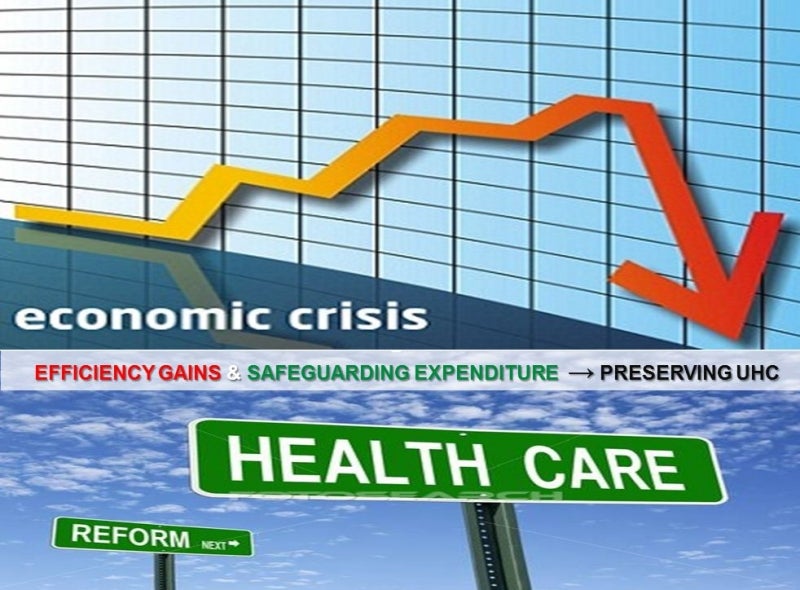
Last week's 2nd Global Symposium on Health System Research in Beijing made me think: Could a global tool for assessing health system vulnerability help to strengthen health systems and move toward universal health coverage in countries? Who would use this tool, and how?
For one, if coupled with policy backing, such global assessment and benchmarking would help identify weak spots, focus attention and resources and, consequently, strengthen system resilience. Many skeptics would not buy that argument. Isn't it better to measure the impact of economic crises directly on health outcomes, using household data that allows for more granularity and, expectedly, more robust causal estimates? But on the other hand, why not go straight to country-specific investigation given the heterogeneity of health systems and the complexity of interactions between the macro economy and the system?
I argue that a global tool could contribute the following:
- Gap Analysis: Starting with the system side of the story, compared to other fields, such as food security and environmental vulnerability, the health system lags behind in providing standardized definitions, metrics, and applied tools that would help assess crisis-related vulnerabilities. There are no descriptive tools that would allow for retrospective comparison, let alone predictive tools that would enable early warning signals.
- Investments to Improve Readiness and Resilience: When it comes to crisis mitigation, readiness matters. A system that has more reserves is more likely to withstand shocks.
- Methodological Rigor vs. Policy Multiplier: Undoubtedly, global tools and league tables that are based on reduced dimensions of determinants to compare country performance suffer from limitations. For example, both the Human Development Index and the Doing Business index have been heavily debated regarding their methodological robustness and interpretation of the rankings. Although such tools are not perfect, they have played an important role in focusing the attention of policy-makers and the development community on shortcomings in these areas, and leveraging significant resources to remedy weaknesses at the country level. Similarly, the policy-multiplier effects of a system vulnerability assessment tool are expected to be high.
- Threats of Social Crisis and Rollback of Universal Health Coverage: The full effects of the global economic crisis, which started in 2007 in the developed world, have likely not fully materialized yet (See related work presented by Chawla, Gottret, and Lewis at IHEA 2009 and by Pita Barros, Thomas, and Yfantopoulos at ECHE 2012 as well as a series in Health Policy Volume 106(1). In the affected OECD countries, with some lag, the shock has already started to hit the social sectors. Crisis is an opportunity for efficiency gains. But the challenge is that where system reforms have already squeezed efficiency, essential services can suffer (see figure 1). When system vulnerability is increasing, coordination between macro stabilization and sectoral needs becomes more important because what penny-wise can be smart, may well end up being pound-wise foolish by undermining long-term investments in human capital. The World Bank is preparing a series of case studies that will be available later this year for countries at all income levels.
Figure 1: Radar Plot with Pre- and Post Crisis Vulnerability Scores[i] for Estonia, Iceland, Greece, and Portugal (2005 and 2010)
Source: Calculations based on macro data from the Fiscal Health Database[ii] - Breaking the Cycle. Recently, the Global Business Leader Survey's confidence measure has declined to 46%—and anything below 50% is considered contraction. Through various pathways (e.g. FDI, remittances, trade, and foreign aid) the continued downturn can trickle further to developing economies. While macro economists and fiscal and monetary policy makers are working to break the cycle, the efforts are not as articulated or visible on the social side. The proposed vulnerability ‘Assessment-Tacking-Mitigation' approach could be a practical empirical tool to inform health sector policies and reform efforts that aim to strategically strengthen system resilience.
- Harmony with WDR 2014 Messages: The World Development Report 2014, which focuses on managing risk for development, proposes that risk management should be a central concern at all levels of society. Although the WDR 2014 places in the front and center insurance as the instrument to manage risk, viewing it from the health system's perspective, there are a number of other factors that contribute to effective risk management, including general taxation for pooled financing, development of targeting mechanisms, and continuous risk assessment and monitoring to mention a few.
Undoubtedly, some regions and countries are currently more in need for vulnerability assessment. These countries are already doing their share to understand and map crisis pathways and effects and devise policies and strategies that can attenuate the economic and social effects of negative shocks (examples: Income Shocks Reduce Human Capital Investments: Evidence from Five East European Countries and Health Policy Responses to the Financial Crisis in Europe). Yet, as crises are unpredictable recurrent events, one never knows where it will hit next. Early diagnosis and prevention is better than fire-fighting and suffering the consequences of doing "too little too late." This is a relatively small investment with potentially high human capital returns. Are we ready?
What do you think?
[i] Note: The vulnerability scores are range standardized and all variables are standardized in terms of interpretation. Uniformly for all measures on the plot, the center of the radar at 0 point indicates low performance on the given variable (i.e. high system vulnerability or low resilience). The outer perimeter of the radar plot at 100 indicates good performance (i.e. low vulnerability or high system resilience). Authors: Velenyi, Yazbeck, and Smitz (forthcoming).
[ii]The Fiscal Health Database is developedby the Health & Economy Program of the HNP Anchor. Contacts: John Langenbrunner, TTL, Lead Economist, HDNHE (jlangenbrunner@worldbank.org), Edit V. Velenyi, Economist, HDNHE (evelenyi@worldbank.org), and Marc Smitz, Consultant (msmitz@gmail.com).



Join the Conversation